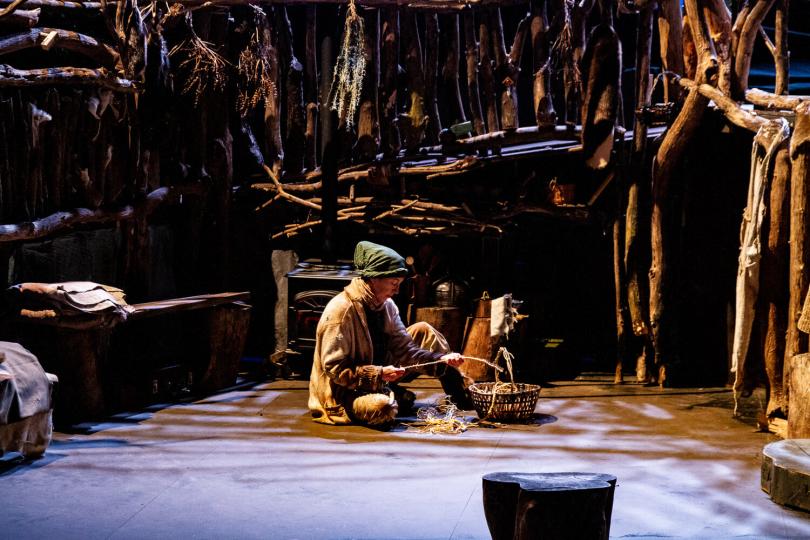This is a Life of Days

Last November I was playing Vira, a woman born and raised in the wilderness who chose to stay on her own after her parents and sibling had died. The original premise of A Life of Days was proposed by Nimbus Theatre playwright Liz Neerland and director Josh Cragun; they put together an ensemble of actors and designers and we immersed ourselves researching how we would have procured food, water and shelter while isolated from the rest of humanity. In the play, Vira is in her 50s when she encournters two young park rangers ; when they invite her to hike out with them and rejoin civilization, she ultimately decides to stay where she is: fetching water every day, catching fish, raising vegetables, gathering berries, drying herbs, chopping wood, braiding rope, mending clothes, resoling shoes, plugging every hole in her humble home. “A Life of Days” is taking one day at a time, routine born out of necessity, the knowledge that the monotony of daily life could be upended by one life-threatening event: a blizzard that caves in the roof, frostbitten feet, poisonous mushrooms for lunch, an infected cut, a wild animal attack (exit, pursued by a bear).
We wondered how Vira could survive mentally in such isolation – no other people, no internet, no television, no radio – only “The 1960 Book of Knowledge Annual” for reading material, an old family photo album and a gramophone brought from her parents’ previous life in society. We decided that Vira probably had bouts of sadness, grief and loneliness but did not panic. She was resilient and continued to do her daily chores; she even adapted to a completely new situation when she opened her front door to strangers one night and the 21st century rushed in like a devil wind.
Unlike many of us in this current pandemic, Vira was equipped with survival skills and self-confidence down to her core – a complete ease about being with herself day after day. The park rangers gave her a glimpse of smart phones and GPS trackers, central heating and indoor plumbing, but she chose to stay alone in her rustic cabin. If she had accompanied her new friends back to the city, or even resettled on a rural farm, she most surely would have been felled by a virus or bacterial infection. She had no exposure to childhood diseases of measles and mumps, let alone a common cold. Although Vira’s parents had lived through the polio epidemic of the 1950s, they evacuated themselves and her older brother in 1962 because they were convinced of worldwide destruction by nuclear war, not by a paralyzing virus. They had seen the development of a vaccine in 1955 that nearly eradicated the disease. They were more afraid that the world would destroy itself with weapons because of geopolitical agendas rather than succumb to polio.
I didn’t think I’d be able to relate so much to Vira’s physical vulnerability so soon after that production; just months ago our creative team was imagining ourselves living in isolation, coming up with dozens of “what if” scenarios and all the hard choices we would have to make. But it’s not so hypothetical anymore as we’re losing loved ones, losing jobs, losing our way of life. I try to remain calm and think about Vira’s priorities – taking care of food, water and shelter first. I realize it’s not a fair comparison to our current situation: she didn’t have to earn money or sustain a business, and she didn’t have any children to take care of and support. Many are contending with working from home while parenting children 24/7 – keeping them engaged while clamping down anxiety and exhaustion. In contrast, some are alone for extended periods in their apartments for the first time. We’ve all felt the loss of physical touch lately as we have family and friends that we can’t hug or comfort in person right now. Vira lost her brother and her one source of human contact, but she had years to adjust to living on her own – because she had to.
Our lives are a juxtaposition between advance planning and living in the moment: we’re thinking days or weeks ahead by rationing money and supplies, while spontaneously dancing in the living room with our kids to take a break from homeschooling. I see my friends posting photos on social media of the seedlings they started inside and the garden beds they are planting now. We’re thinking through all of our basic provisions, from flour to toilet paper, then painting rainbows to put in our windows. We’re dusting off long-neglected sewing machines, musical instruments and art supplies; we’re doing goofy, creative things we haven’t done in years. At the same time we’re doing practical things like learning new technology to communicate with each other and adapt our artistic work to living with a pandemic.
I’ve done so many plays over the years that have paralleled something that was going on in my life or been attracted to a character because of a similar background to mine. Usually experience helps prepare me for a role, but the role of Vira also helped prepare me for this shelter-in-place life. I enjoyed playing her because I could aspire to be this kick-ass woman who lives by herself in a mountain forest. Do I have her wilderness skills? No. Do I have her self-confidence? Maybe a little. Do I have her curiosity, adaptability and resiliency? Yes, I think I have a lot of that. Some of it I learned from imagining myself in her place, and some of it was already there because I’ve been doing theatre for so long. Maybe it took Vira to remind me that as theatre artists we’re always improvising and making do with whatever we find in the closet or the dumpster. We make the best choices we can in the moment, and we take care of each other.




